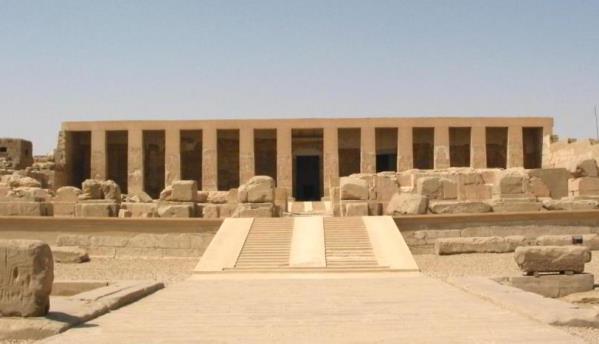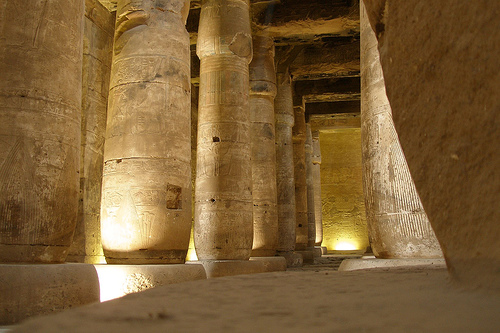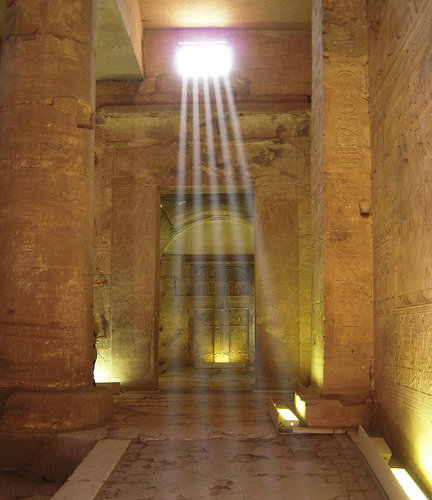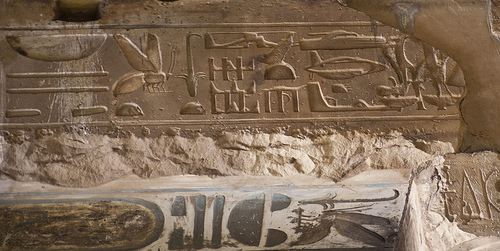

Location: 45 km (29 mi) Southwest of Sohag, Sohag Governorate Map
Abydos or Abidos is situated 45 km (29 mi) Southwest of Sohag, Sohag
Governorate in Egypt. It was known in the ancient times as Tha Shard
or "The Great Land". For centuries it was one of the most important
and largest religious and cultural center of the Ancient Egypt.
Abydos was a site of cult of god Osiris, a lord of the underworld.
Thousands of pilgrims from Egypt and beyond tried to make their way
into Abydos to leave an offering. Unlike monotheistic religions that
we know today, ancient pagan cults was not centered so much on a
person himself or herself, but on the actions and gifts he or she
can deliver. In fact Egyptians had interesting prayers in the Book
of the Dead that begged their hearts not to betray them then they
will on their final judgment. Lying and cheating your way into
Heaven was a normal religious practice.
One of the most
impressive temples of Abydos was constructed by Pharaoh Seti I from
the XIX Dynasty. It was dedicated to the seven great deities of
Egypt. The central sanctuary of the temple was dedicated to Amun-
Ra. Just to the right of this sanctuary is another sanctuary devoted
to the triad of deities: god Osiris himself, his wife Isis
(fertility goddess) and their son Horus. To the left of the central
sanctuary was a sanctuary devoted to Sun God Ra- Horahte and "lord
of crafts" Ptah. This seventh and last sanctuary was intended for
funeral cult of the pharaoh Seti himself. Additionally pious pharaoh
did not forget to mention 76 names of his ancestors that were
supposed to be remembered in the after life beginning with king
Menes, the founder of the dynasty. Egyptians put a huge emphasis on
remembering the name of the dead ones. In fact the worst punishment
you can inflict on your enemy is erasing his name. You can find this
kind of barbarism in many different sites all around the Egypt.
During times of festivities numerous ships, boats and papyrus rafts
made their way from the Nile River through a spacious channel into
the heart of Abydos. Once people set their foot in the harbor they
were greeted by musicians, flowers girls and priests who stood at
the top of the long double staircase that led to the temple. Two
copper covered doors were opened and pilgrims could see the first
courtyard. In the center of the courtyard stood two round stone
water tanks with a diameter of 10 feet. Pious travelers would wash
themselves before praying. The South side of the courtyard opened
into a monumental passage that led to the Audience Hall surrounded
by columns. It was intended for pharaoh and noble pilgrims.
The second courtyard of the temple covered an area of six hundred
square meters. In the western part of the courtyard is a small
platform on which there are twelve square pillars, the height of
about eight meters, supporting the roof portico. Surface of the
pillars and the wall behind them were adorned with beautiful reliefs
added here during the reign of pharaoh Ramses II.
Through
the door in the portico called the Passage of Gloomy you get to the
first pillared hall of the temple. Twenty-four columns mimic the
closed buds of the papyrus. The ceiling is covered with images of
the goddess Nehbet that prostrates her wings, as if protecting a
sacred place. On massive blocks of the architrave are written the
names of the Seti, and his son Ramses. Penetrating through the
square holes in the ceiling, the sun's rays illuminate the ghostly
famous reliefs of very fine work, covering every inch of the walls.
Almost all of the reliefs preserved their native vivid color and are
considered to be unsurpassed masterpieces of ancient Egyptian art.
On the reliefs of Amon-Ra, his consort Mut, a solar-Ra and the
goddess of love Horahte Hathor greeted the king and graciously
accept his gift, a sacred leaf, fragrant oils, lotus flowers and
milk. Pharaoh Seti is greeted as equal by god Ptah, lord of Memphis
and his formidable wife - lion-headed Sekhmet. The god Khnum,
depicted in one wall of the Hall of Columns, using a potter's wheel
creates the physical body of the pharaoh. The goddess Isis cuddle
born into the world of the royal infant, gently touching the tip of
his chin with his fingers. A little further four incarnations of the
goddess Hathor.
Seven doorways open in the second pillared
hall. Again, the columns in the form of papyrus buds support the
ceiling. Floor level slowly rises. Central place in the relief image
is occupied by the royal coronations by deities themselves. Here
pharaoh Seti on his knees gets the royal scepter and sword Hepesh, a
symbol of a victorious war, from the hands of the gods and goddesses
of the Nile Valley, that give king "millions of years of the reign".
For the sanctuary of the god Osiris, unlike other Egyptian
temples, at Abydos there were special facilities for the commission
of the mysterious ceremonies which the Greeks called "mysteries".
According to the inscriptions on some of the pillars in this temple,
current religious complex was erected on the ruins of their more
ancient sanctuary. It might be merely a bluff to impress his
subjects or a real building. There were no attempts to find the
validity behind this claim. This region certainly had a special
religious place for Egyptians. In the west, behind the temple of
Seti I, once a hidden tree-lined hill, had a sacred underground
tomb, often called "Osiriyonom" or "Osireion", where according to
ancient Egyptian legend, the goddess Isis buried the head of Osiris,
god of the desert killed Seth and resurrected to a new and eternal
life.
Despite centuries Abydos impresses with its mysterious
and gloomy atmosphere. If in Karnak you met an animated history the
way Egyptians saw it, here in Abydos you will met a more spiritual
side of the Egyptian society.


Probably the most famous carving in Abydos that according to some depicts a helicopter, a plane and a submarine or a tank. Although it might be long stretch of imagination this type of symbols have not been found anywhere else in the country. Furthermore they don't look like anything that was previously found on Egyptian sites.

The oldest traces of settlement from Abydos date from the late
predynastic period and were found in the area of the later temple of
Seti I and the city proper. It cannot be determined whether Abydos was
already fortified at that time.
In ancient times, dogs and
jackals were commonly found in cemeteries and were viewed as god-like
guardians of the necropolis. In Abydos this was the dog- or jackal-like
god Chontamenti (“first of the western = deceased”), who was initially
worshiped there as a local deity.
Until the end of the 1st
Dynasty, servants and followers were buried in Abydos at the same time
as the pharaohs to serve the rulers in the afterlife, initially up to
around 300 bodies, and towards the end of this practice increasingly
fewer. Apparently the companions were killed for this purpose.
The temples for the death cult of the deceased kings were located closer
to the fruit land and were built in the early days from wattle and daub
that has now fallen apart. They can only be recognized by the rows of
graves for members of the court surrounding them.
Brick
construction began in the 2nd Dynasty, of which two are still standing:
the Shunet El-Zebib (“raisin barn”) and another in which the Coptic
monastery Amba Mousa is located. The tombs known as the solar barges of
Abydos date from this period.
At least since King Djoser of the
3rd Dynasty, Abydos was abandoned as a royal necropolis and the rulers
were buried in Lower Egypt (Sakkara, Giza, Abusir, Dahshur), but a mock
burial seems to have been carried out in Abydos. But as late as the 6th
Dynasty, many high officials were buried in Abydos.
King Pepi I built a burial chapel in Abydos, which over the years
developed into a temple of Osiris and whose remains still exist. During
the First Intermediate Period, Abydos was part of Theban territory, but
was fiercely contested. King Merikare's father is said to have destroyed
the old royal tombs. During this period of cultural reorientation,
Abydos took over the status of Memphis as a royal residential
necropolis. This profound change represented a reference to ancient
traditions of Abydos as an early royal necropolis.
With the
change to Abydos as a new mortuary center and the upgrading to the “holy
cult site of Osiris” there was a “theological anachronism” that
relocated the Osiris worship that arose at the end of the Old Kingdom to
a time in which the deity Osiris did not yet exist. The rites of a mock
burial thus became the mystery of Osiris, who was “buried in Abydos” and
then resurrected in his statue. During this time, Osiris associated
himself with the ancient necropolis god Chontamenti.
Since the
Middle Kingdom, it has been the wish of many Egyptians to either be
buried in Abydos or at least to be present there with a stele. This led
to many officials in Abydos having a chapel with steles, statues and a
sacrificial table, or even just a stele, built. The majority of Middle
Kingdom stelae come from Abydos. Osiris mysteries were apparently also
performed in Abydos. They are mentioned on various steles. There are
also extensive cemeteries from this period near Abydos.
From the
11th Dynasty, an ancient temple was rebuilt in the center of the city.
Sesostris III. built a huge Osiris tomb for himself in the southeast of
Abydos. The valley temple was located on the edge of the desert, an
approximately 700 m long path led to the burial area, which formed a
T-shaped brick platform 156 m wide and 160 m long. In the northern part,
two shafts led into the 24 m deep grave. The 180 m long grave corridor
was closed with granite and quartzite slabs. The actual coffin chamber
was hidden. The elaborate complex leads some Egyptologists to suspect
that Sesostris III. was not buried in his pyramid, but here.
Next
to the Valley Temple was also the city of Wahsut, founded by Sesostris
III. founded, but was abandoned again in the New Kingdom. It served the
temple cult, but probably also had national significance.
King
Chendjer (13th Dynasty) had a life-size statue of Osiris erected in the
Tomb of Djer, which was now considered the Tomb of Osiris.
After the unification of the empire, Ahmose built for himself, his
grandmother Tetischeri and also for Queen Ahmose-Nefertari south of
Sesostris III's. Mock tombs with pyramids were built in the temple
complex. Still under Amenhotep III. The grave of Djer was regarded as
the grave of Osiris.
In the 19th Dynasty, it was mainly Seti I
and Ramses II who built huge temple complexes in Abydos (mortuary temple
of Seti I, temple of Ramses II). The high priests of Osiris, such as B.
Wennefer were leading figures in the country at this time.
Abydos
retained its importance in the late period. There are important grave
complexes of high officials from the Third Intermediate Period and in
the 25th Dynasty (approx. 660 BC) some members of the Kushite royal
family were buried here.
In late antiquity, a garrison was stationed in Abydos. Little is known about the extent of the city; Roman and Coptic house remains in and around the large temple of Seti I are the only clues. In the area of the Amba Mousa monastery there has been a village called Deir Sitt Damyana since the Middle Ages. Further remains of Coptic settlement include a church built over a New Kingdom temple and smaller residential buildings in ancient tombs.
Kom el Sultan
One kilometer north of Umm el-Qaab lies the ruins of
Kom el-Sultan. There are various burial sites, a craftsmen's settlement
and the temple of Osiris-Chontamenti. The development of the complex
dates back to the predynastic period.
Umm el-Qaab
In the early
Umm el-Qaab cemetery, about 3 kilometers from the edge of the desert and
2 kilometers from the city, the graves of most of the rulers of Egypt's
early dynastic period have been located, which are located in the
so-called B cemetery. In the underground cemetery next to it, additional
graves were discovered that could be attributed to the kings of the
pre-dynastic period. The most important archaeologists who worked on
this royal cemetery were Émile Amélineau, Flinders Petrie, Édouard
Naville, Eric Peet and, since 1997, the DAI in Cairo under Werner Kaiser
and Günter Dreyer. In 2000, the oldest ship finds from around 3000 BC
were discovered here. Made. 14 approximately 20 - 30 m long ship hulls
were buried in the sand and are being recovered and preserved by a team
from the University of Pennsylvania Museum, Yale University and the
Institute of Fine Arts at New York University. The ships are attributed
to the 2nd Dynasty.
Mortuary Temple of Seti I
One kilometer south of Kom el-Sultan is
the mortuary temple of Seti I, which is the largest well-preserved New
Kingdom building in Abydos. The L-shaped limestone temple was named “The
House of Million Years of King Menmaatre, who is content in Abydos”. Two
wide courtyards lead to the temple house with its pillared facade, which
is adjoined by two further pillared halls. This is followed, slightly
elevated, by a series of seven sanctuary, which are dedicated to the
local deities (Osiris, Isis and Horus), the imperial deities (Amun-Re,
Re-Harachte and Ptah) and the deified King Seti. The Osiris sanctuary is
adjoined by rooms in which mystery celebrations were held. A southern
extension of the temple contains the important king list of Abydos with
the predecessors of Seti I. Although the most important Egyptian deities
were worshiped in the Seti temple, the focus was on the king's
connection with Osiris and his deified ancestors, in keeping with the
royal tradition New Kingdom mortuary temple. The actual temple is
located in a large brick complex (220 × 350 meters), which contains two
open courtyards and rows of mud brick magazines on the south side. A
rear gate within a brick pylon faces the archaic royal cemetery at Umm
el-Qaab. Like the temple complex at Kom el-Sultan, the Temple of Seti
was linked to the supposed burial site of Osiris both conceptually and
through ritual processions.
Osireion
Behind the temple is an
underground structure called the Osireion, which functioned as the
symbolic tomb or cenotaph of Osiris. The structure was excavated
primarily in 1902–1903 by Margaret Murray in collaboration with Petrie.
The main central chamber contains a central platform and ten monolithic
pillars made of red granite. The architecture is intentionally archaic,
mimicking the monolithic architecture of the 4th Dynasty. The central
platform is surrounded by water channels and is said to represent the
primordial mound of creation, surrounded by the waters of the Nun.
Adjoining the main chamber are other chambers and passages that contain
scenes and texts from the Book of Gates and the Book of the Dead, which
are typical elements of Ramesside royal tombs. Adjoining the Temple of
Seti was a smaller chapel dedicated to Seti's father Ramesses I, which
is now in the Metropolitan Museum in New York. Further north are the
well-preserved remains of a temple built by Ramesses II. Remains of
other Ramesside royal buildings lie along the desert edge between Seti
Temple and Kom el-Sultan.
The area south of Seti Temple is the
least explored area of Abydos, as the modern city of Arabah el-Madfunah
covers most of this area. In all likelihood, this location was home to
the largest concentration of settlements from the New Kingdom onwards.
Abydos South covers an area of about two square kilometers in a one
kilometer wide desert strip between the fruit land and the desert
mountains. In predynastic times the area was used for settlements and
cemeteries. The greatest development took place in the Middle Kingdom,
when the first of several royal cult complexes for Sesostris III was
built here. was built.
Temple and tomb of Sesostris III.
The
complex of Sesostris III. consists of a large underground tomb and a
mortuary temple. It was first studied by David Randall-MacIver and
Arthur Weigall of the Egypt Exploration Fund between 1899 and 1902 and
then excavated in the 1990s by the University of Pennsylvania under the
direction of Josef W. Wegner. A large planned settlement south of the
mortuary temple is similar in size and structure to the city of Illahun,
which adjoins the pyramid complex of Sesostris II. Work from 1997
identified the name of this temple city foundation as “Permanent are the
sites of Chaikaure the Justified at Abydos.”
Monuments of Ahmose
and Tetisheri
Half a kilometer south of the Sesostris III complex
stand the remains of several monuments built by King Ahmose of the 18th
Dynasty. A pyramid and temple located on the Fruitland border are
connected to an underground tomb in the desert. This was the last royal
pyramid built in Egypt. In 1993, Stephen P. Harvey examined the Pyramid
Temple and uncovered remains of a small temple inscribed with the title
of Queen Ahmose-Nefertari and possibly dedicated to her cult. Between
the Ahmose pyramid and the underground tomb is a small chapel dedicated
to Ahmose's grandmother, Queen Tetischeri. A well-preserved stele, now
in the Cairo Museum, was discovered in the Tetischeri Chapel. The Ahmose
complex also includes a terrace temple on the lower hill, which is
incomplete and has an unknown function.